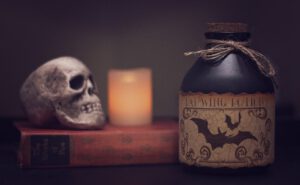
Biggest Halloween Risk for Kids May Be Surprising; Secondhand Tobacco Smoke More Deadly Than Auto Accidents or Adulterated Treats
Q3 2020 hedge fund letters, conferences and more
WASHINGTON, D.C. (October 26, 2020): Although the pandemic is likely to put a damper on some trick-or-treating by children this year, millions of parents, grandparents, family friends, and neighbors will probably warn young children about the dangers of motor vehicle accidents, or of eating candy which hasn’t been inspected.
Secondhand Tobacco Smoke: The Biggest Halloween Risk For Kids
But most will probably fail to warn about the biggest risk – one which may kill more children this Halloween than all of the others combined; adults smoking in their presence.
According to a detailed analysis by the Centers for Disease Control, “during 1975-1996, from 4 p.m. through 10 p.m. on October 31, a total of 89 deaths occurred among pedestrians aged 5-14 years, compared with 8846 on all other evenings.
Overall, among children aged 5-14 years, an average of four deaths occurred on Halloween during these hours each year, compared with an average of one death during these hours on every other day of the year.”
A study published in the Journal Pediatrics concluded that, on the average, in the 42 years from 1975 to 2016, fewer than 2 pedestrians aged 4-8 died each year on Halloween as a result of traffic accidents.
State Farm analyzed four million records in the Fatality Analysis Reporting System (FARS) from 1990-2010 and found that, among pedestrians up to 21 years of age, there was an average of 5.5 fatalities each year on October 31.
Similarly, a “Washington Post analysis found that 54 pedestrians younger than 18 were struck and killed by an automobile on Halloween from 2004 through 2018”; an average of fewer than 4.
Deaths Caused By Adult Smokers
As regrettable as all these deaths are, the numbers – whether it’s 4, 5.5., or whatever – pale in comparison with almost 20 deaths among children killed each Halloween – as well as every other day of the year – by adult smokers, says public interest law professor John Banzhaf, who started the nonsmokers’ rights movement by getting smoking restricted and then banned on airplanes.
According to the Archives of Pediatric Adolescent Medicine, secondhand tobacco smoke kills more than one thousand children every year from diseases including respiratory syncytial bronchiolitis, asthmatic attacks, and other respiratory complications.
This doesn’t even include the larger number of deaths among infants each year from SIDS apparently triggered by tobacco smoke, notes Banzhaf, who also helped bring into operation the first international antismoking and nonsmokers’ treaty, which was a major factor in obtaining smoking bans in public places now in effect in many countries.
The New York Times has gone much further, reporting, based upon another study, that “at least 6,200 children die each year in the United States because of their parents’ smoking, killed by such things as lung infections and burns . . More young children are killed by parental smoking than by all unintentional injuries combined.”
Banzhaf points out that the 6,200 annual pediatric death toll does not include children killed by smoking grandparents and other guardians, nor those killed in fires caused by careless smokers other than their parents; noting that cigarette smoking is the major cause of residential fire deaths, including those in apartments and other multi-family dwellings.
Respiratory Infections In Kids
The Environmental Protection Agency (EPA) estimates that each year, even at the levels found in a home where only one parent smokes, tobacco smoke still causes in children some 150,000-300,000 lower respiratory infections like pneumonia and bronchitis; 7,500-15,000 hospitalizations; 200,000-1,000,000 asthma attacks; 8,000-26,000 new cases of asthma, and – as noted – a large increase in deaths from SIDS.
Another study shows that at little as 20 minutes of exposure to secondhand tobacco smoke can impair the breathing of nonsmokers. Although the study involved only adults, it’s quite likely that the effect would be even greater among children because their tiny lungs are still developing, and because young children tend to be far more sensitive to many airborne pollutants than adults, suggests the professor.
Also, residences of friends or relatives, as well as other indoor areas where smoking occurs, even when children are not present – including, for example, day care centers – can contain large deposits of tobacco smoke residue which can quickly trigger asthma attacks and other forms of respiratory distress in young children, and has also been proven to cause cancer.
Warn Children This Halloween
For these and other reasons, professor Banzhaf suggests that adults should warn children this Halloween, and also on other days, against visiting, going to parties, or playing in homes where smoking occurs, especially if it occurs in their presence.
They should also stay away from a parent, grandparent or other adult while that person is smoking, and avoid being seated in the smoking sections of restaurants – and in cars when adults are smoking – where exposure to deadly secondhand tobacco smoke is far higher.
The National Confectioners Association and others say that the idea the Halloween candy is likely to be tainted with razor blades or poison is largely an urban myth, and there appear to be no reliable figures on any children dying as a result of consuming tainted candy.
So parents, grandparents, neighbors and other responsible adults should give more attention to warning children about more clearly established dangers, rather than those about which they are traditionally cautioned every Halloween season, says Banzhaf.
The post Secondhand Tobacco Smoke More Deadly Than Auto Accidents or Adulterated Treats appeared first on ValueWalk.
